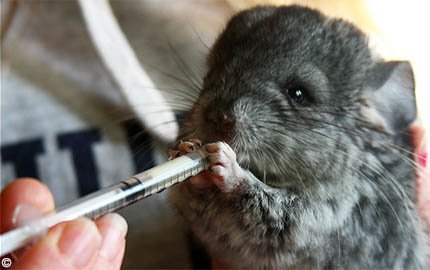
Hand Feeding Definition ... manually inputting fluid (water/milk) and substance food (pellets/hay) into a chinchilla.
Hand feeding a chinchilla can seem quite an ordeal especially if it is a sick chinchilla that is used to feeding themselves or a new born kit rejected by its mother/siblings.
In all instances when a chinchilla cannot feed themselves it is imperative that you step in and hand feed a chinchilla as they loose weight rapidly! If a chinchilla does not eat for a while their gut movement also begins to slow down, which can cause the onset of G. I. Statis that is fatal to chinchillas if ignored.
It is seriously important to weigh chinchillas that are being hand fed on a regular basis of every 2-3 days. Making weigh-ins more regular than the usual once a week will ensure no massive weight losses go unnoticed.
 Hand feeding must be done very carefully as to not let food go down the trachea or windpipe, which can cause the onset of Pneumonia or drop into the nostrils as to strangle the chinchilla.
Hand feeding must be done very carefully as to not let food go down the trachea or windpipe, which can cause the onset of Pneumonia or drop into the nostrils as to strangle the chinchilla.
When hand feeding older chinchillas care must also be taken to ensure the chinchilla does not bite off the end of the syringe and swallow it.
Hand Feeding a Sick Chinchilla...
Chinchillas can stop eating for various reasons and at any time a chinchilla chooses to stop feeding itself, immediate medical intervention must be sought to diagnosis the underlying health issue.
Some chinchillas have the onset of tooth issues, which will prevent them eating properly as they find crunching onto hard pellets to painful to tolerate, if this is the case, before you commence hand feeding, try the following two methods:
- Crush down the pellets using a coffee grinder until the pellets resemble crumbs and see if the chinchilla can consume the crumbs, if not...
- Add a couple of drops of water to the pellets until they are mushy but not completely wet.
The above can be offered from a spoon or food bowl but if the chinchilla refuses this method of eating, then 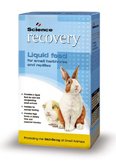 hand feeding a 'liquid feed' on a regular basis will need to start with the aid of a feeding syringe or pipette.
hand feeding a 'liquid feed' on a regular basis will need to start with the aid of a feeding syringe or pipette.
There are liquid foods available for chinchillas that can be bought from a professional veterinary surgery and these food forms can be hand fed to a chinchilla via a feeding syringe. The common hand feeding brands are Science Supreme Recovery and Critical Care. Both come in sealed sachets and are classed as 'complete foods' in powder form. They contain all the essential nutrients a chinchilla would normally acquire from their normal diet of pellets and hay although the level of protein, carbohydrates and fibre are increased as required by a sick or unable chinchilla that is being hand fed.
 Most syringes for small animals are 1ml of content, this should be remembered when hand feeding a chinchilla to ensure they are acquiring the full amount - a sick chinchilla may eat less but monitor the amount you hand feed daily. Science Supreme Recovery suggests you hand feed one sachet per kilo of chinchilla body weight per day.
Most syringes for small animals are 1ml of content, this should be remembered when hand feeding a chinchilla to ensure they are acquiring the full amount - a sick chinchilla may eat less but monitor the amount you hand feed daily. Science Supreme Recovery suggests you hand feed one sachet per kilo of chinchilla body weight per day.
If a chinchilla does not like the taste or texture of the liquid food you can try and make your own liquid supplement and see how you get on. Make a BASIC chinchilla mix using chinchilla pellets, water (to liquefy) and add a small amount of Nutrobal (calcium and mineral supplement) and Avipro Plus (probiotic) to the formula. Mix well together and offer to a chinchilla through a syringe or pipette.
Hand Feeding a Chinchilla Kit (Baby) ...
Please refer to our section on Weaning & Hand-Rearing A Chinchilla Kit.
Hand Feeding Method:
Firstly when hand feeding a chinchilla, the most important aspect is to relax and allow plenty of time for the feeding process. Try not to make the chinchilla feel like it is being hand fed and make sure everything is prepared first. Place everything on a tray: liquid feed, syringe of water (if not drinking), medications, tissue paper for cleaning up and keep it all to hand.
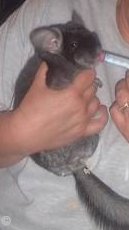 A chinchilla may take directly to a syringe whilst running about and you should try this first but if not you will need to pick the chinchilla up and hand feed them manually.
A chinchilla may take directly to a syringe whilst running about and you should try this first but if not you will need to pick the chinchilla up and hand feed them manually.
Fill the syringe with a hand feeding liquid-food such as Science Supreme Recovery or Critical Care and expel any air bubbles before you gently pick the chinchilla up.
Hold the chinchilla close to your body with their face towards you and wait until they stop struggling and settle down. Place the tip of the syringe into the mouth by entering from the side, into the gap (diastema) behind the front teeth, and slowly depress the syringe allowing a TINY amount of liquid food to enter the mouth cavity.
As soon as a small amount of food is expelled into the chinchilla’s mouth, immediately remove the syringe to give the chinchilla time to swallow and not choke from too much food.
If at any point during hand feeding the chinchilla begins to struggle, stop for a few minutes and restart hand feeding again when the chinchilla has relaxed. When you have finished hand feeding your chinchilla, wipe away any spillage and repeat the procedure until all the food has been digested. After a couple of goes, you will know how much your chinchilla willingly consumes in one go and each hand feeding session will become easier and easier as time goes on.
NOTE: If the liquid food is smooth enough and a chinchilla is still able to drink water, the liquid food can be offered via a separate water bottle attached to the inside of the cage.
It is important not to rush hand feeding and expel too much liquid food into a chinchilla’s mouth as this can cause choking and food that is inhaled can cause lethal pneumonia! Young kits can also die from over feeding whilst being hand fed as owners offer too much liquid food without knowing.
Be patient and you will win. No chinchilla chooses to be hand fed and it will take some patience and time for them to adjust but you must not give up as a chinchilla's life will depend on you!
Further Reading Relating To Hand Feeding A Chinchilla:
Holding a Chinchilla, Illness Sickness & Disease, Nutrition (Food & Diet), Weaning & Hand-Rearing A Chinchilla Kit,
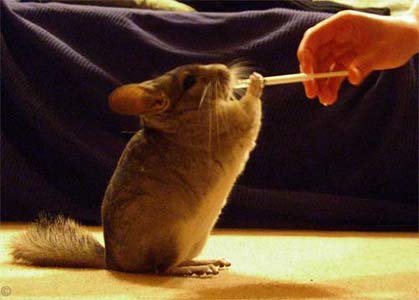

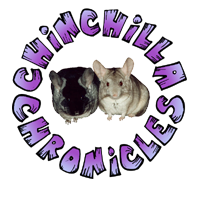

 Hand feeding must be done very carefully as to not let food go down the trachea or windpipe, which can cause the onset of
Hand feeding must be done very carefully as to not let food go down the trachea or windpipe, which can cause the onset of  hand feeding a 'liquid feed' on a regular basis will need to start with the aid of a feeding syringe or pipette.
hand feeding a 'liquid feed' on a regular basis will need to start with the aid of a feeding syringe or pipette. Most syringes for small animals are 1ml of content, this should be remembered when hand feeding a chinchilla to ensure they are acquiring the full amount - a sick chinchilla may eat less but monitor the amount you hand feed daily. Science Supreme Recovery suggests you hand feed one sachet per kilo of chinchilla body weight per day.
Most syringes for small animals are 1ml of content, this should be remembered when hand feeding a chinchilla to ensure they are acquiring the full amount - a sick chinchilla may eat less but monitor the amount you hand feed daily. Science Supreme Recovery suggests you hand feed one sachet per kilo of chinchilla body weight per day. A chinchilla may take directly to a syringe whilst running about and you should try this first but if not you will need to pick the chinchilla up and hand feed them manually.
A chinchilla may take directly to a syringe whilst running about and you should try this first but if not you will need to pick the chinchilla up and hand feed them manually.